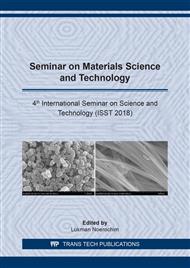[1]
Taufiqqurrahman, N.S., Hidayat, M.I.P. and Rasyida, A. (2016), Evaluasi Numerik Untuk Delaminasi Komposit Double Cantilever Beam Dengan Cohesive Zone Model,, Jurnal Teknik ITS, Vol. 5, No. 2, ISSN: 2337-3539.
DOI: 10.12962/j23373539.v5i2.18017
Google Scholar
[2]
Lindgaard, E., Bak, B.L.V., Glud, J.A., Sjølund, J. and Christensen, E.T. (2017), A User Programmed Cohesive Zone Finite Element for ANSYS Mechanical,, Engineering Fracture Mechanics, Vol. 180, pp.229-239.
DOI: 10.1016/j.engfracmech.2017.05.026
Google Scholar
[3]
Garg, Amar C. (1988), Delamination-A Damage Mode in Composite Structures,, Engineering Fracture Mechanics, Vol. 29, No. 5, pp.557-584.
DOI: 10.1016/0013-7944(88)90181-6
Google Scholar
[4]
Pascoe, J.A., Alderliesten, R.C. and Benedictus, R. (2013), Methods for the Prediction of Fatigue Delamination Growth in Composites and Adhesive Bonds - A Critical Review,, Engineering Fracture Mechanics, Vol. 112-113, pp.72-96.
DOI: 10.1016/j.engfracmech.2013.10.003
Google Scholar
[5]
Turon, A., Dávila, C.G., Camanho, P.P. and Costa, J. (2007), An Engineering Solution for Mesh Size Effects in the Simulation of Delamination Using Cohesive Zone Models,, Engineering Fracture Mechanics, Vol. 74, pp.1665-1682.
DOI: 10.1016/j.engfracmech.2006.08.025
Google Scholar
[6]
Waseem, M. and Kumar, K. (2014), Finite Element Modeling for Delamination Analysis of Double Cantilever Beam Specimen,, SSRG International Journal of Mechanical Engineering (SSRG-IJME), Vol. 1, Issue: 5, pp.27-33, ISSN: 2348-8360.
DOI: 10.14445/23488360/ijme-v1i5p105
Google Scholar
[7]
Barbero, E.J. (2014), Finite Element Analysis of Composite Materials Using ANSYS, 2nd Edition, CRC Press., Taylor & Francis Group, Boca Raton, Florida, USA.
Google Scholar
[8]
Krieger, W. E. R. (2014), Cohesive Zone Modeling For Predicting Interfacial Delamination in Microelectronic Packaging, Thesis MS.Eng, Georgia Institute of Technology, Atlanta, USA.
Google Scholar
[9]
ASTM D5528-01 (2007), Standard Test Method for Mode I Interlaminar Fracture Toughness of Unidirectional Fiber-Reinforced Polymer Matrix Composites,, ASTM International, West Conshohocken, Pennsylvania, United States.
DOI: 10.1520/d5528
Google Scholar
[10]
Amiri-Rad, A., Mashayekhi, M. and van der Meer, F.P. (2017), Cohesive Zone and Level Set Method for Simulation of High Cycle Fatigue Delamination in Composite Materials,, Composite Structures, Vol. 160, pp.61-69.
DOI: 10.1016/j.compstruct.2016.10.041
Google Scholar
[11]
Alawadhi, Esam M. (2010), Finite Element Simulations Using ANSYS, CRC Press., Taylor & Francis Group, Boca Raton, Florida, USA.
Google Scholar
[12]
Elmarakbi, A. (2011), Finite Element Analysis of Delamination Growth in Composite Materials using LS-DYNA: Formulation and Implementation of New Cohesive Elements,, In Advances in Composite Materials – Ecodesign and Analysis, Edited by Dr. Brahim Attaf, Chapter 18, pp.409-428, InTech Publisher, Croatia.
DOI: 10.5772/13862
Google Scholar
[13]
Rhymer, J.D. and Kim, H. (2013), Prediction of Delamination Onset and Critical Force in Carbon/Epoxy Panels Impacted by Ice Spheres,, CMC - Computers, Materials and Continua, Vol. 35, No. 2, pp.87-117.
Google Scholar
[14]
Williams, J.G. (1989), The Fracture Mechanics of Delamination Tests,, Journal of Strain Analysis for Engineering Design, Vol. 24, No. 4, pp.207-214.
Google Scholar


